-
Countries
-
Data and Analysis
-
Special Focus
-
Crisis Responses
Chad — Emergency Tracking Tool Report
Country
Title Standard
Chad — Emergency Tracking Tool Report # (DATE)
Operation
Contact
DTM Chad, dtmtchad@iom.int
Component
Domain
Confidential
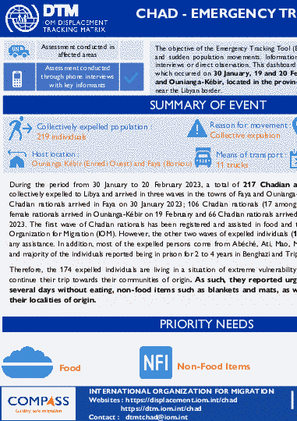
Contact
DTM Chad, dtmtchad@iom.int
Language
English
Location
Chad
Period Covered
Jan 30 2023
Feb 20 2023
Activity
- Mobility Tracking
- Event Tracking
This dashboard presents information on a movement which occurred on 30 January, 19 and 20 February 2023 in the towns of Faya and Ounianga-Kébir, located in the provinces of Borkou and Ennedi-Ouest, near the Libyan border.During the period from 30 January to 20 February 2023, a total of 217 Chadian and 2 Nigerian nationals were collectively expelled to Libya and arrived in three waves in the towns of Faya and Ounianga-Kébir. Among these individuals, 45 Chadian nationals arrived in Faya on 30 January 2023; 106 Chadian nationals (17 among them are minors) and 2 Nigerian female nationals arrived in Ounianga-Kébir on 19 February and 66 Chadian nationals arrived in Ounianga-Kébir on 20 February 2023.
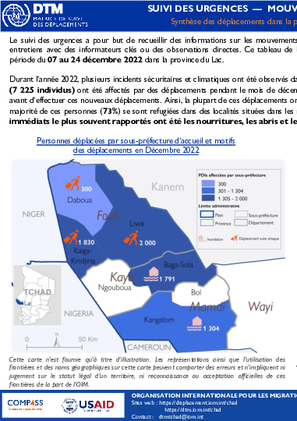
Contact
DTM Chad, dtmtchad@iom.int
Language
French
Location
Chad
Period Covered
Dec 07 2022
Dec 24 2022
Activity
- Mobility Tracking
- Event Tracking
Le suivi des urgences a pour but de recueillir des informations sur les mouvements importants et soudains de populations. Les informations sont collectées à travers des entretiens avec des informateurs clés ou des observations directes. Ce tableau de bord présente les informations sur les mouvements des personnes survenus pendant la période du 07 au 24 décembre 2022 dans la province du Lac.
Durant l’année 2022, plusieurs incidents sécuritaires et climatiques ont été observés dans la province du Lac engendrant des milliers de déplacements. Au total, 1 479 ménages (7 225 individus) ont été affectés par des déplacements pendant le mois de décembre 2022. Par ailleurs, toutes ces personnes étaient membres des communautés locales avant d’effectuer ces nouveaux déplacements. Ainsi, la plupart de ces déplacements ont été causés par les attaques armées (57%) et les inondations fluviales (43%). En effet, la majorité de ces personnes (73%) se sont refugiées dans des localités situées dans les mêmes sous-préfectures que leurs lieux des provenances (voir le tableau 1). Les besoins immédiats le plus souvent rapportés ont été les nourritures, les abris et les articles non alimentaires.

Contact
DTM Chad, dtmtchad@iom.int
Language
English
Location
Chad
Period Covered
Dec 07 2022
Dec 24 2022
Activity
- Mobility Tracking
- Event Tracking
The purpose of the Emergency Tracking Tool (ETT) is to collect information on large and sudden population movements as well as on security and climate emergencies. This dashboard provides information on movements which occurred during the period from 07 to 24 December 2022, in Lac Province.
During 2022, several security and climatic incidents have been observed in the Lake Province, resulting in thousands of displacements. A total of 1,479 households (7,225 individuals) were affected by displacement in December 2022. Furthermore, all these persons were previously local communities before these new displacements. Most of these displacements were caused by armed attacks (57%) and river flooding (43%). Indeed, the majority of these persons (73%) took refuge in localities situated in the same sous-prefectures to their places of provenance (see Table 1). The most reported immediate needs were food, shelter and non-food items.

Contact
DTM Chad, dtmtchad@iom.int
Language
French
Location
Chad
Period Covered
Dec 03 2022
Dec 03 2022
Activity
- Mobility Tracking
- Event Tracking
En date du 22 au 25 Novembre quelques villages cités dans les fiches d’évaluation de la sous-préfecture de Karal département de Dagana et la province de Hadjer Lamis ont été inondés par la remonté des eaux du lac Tchad selon l’évaluation rapide faite le 03 décembre 2022. Selon cette évaluation ces villages ont enregistré plusieurs personnes déplacés ; des enfants, les femmes et les personnes âgées ont quitté leurs lieux de résidence pour aller se refugiés dans les villages environnants notamment Karal, Mouloumirie, Baltrame, Karga etc.
Ces ménages ont indiqué que leurs abris ont été partiellement ou totalement détruits, créant des besoins prioritaires de nourriture, services de santé, éducation, couvertures et bâches.
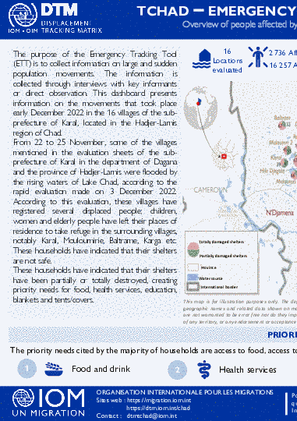
Contact
DTM Chad, dtmtchad@iom.int
Language
English
Location
Chad
Period Covered
Dec 03 2022
Dec 03 2022
Activity
- Mobility Tracking
- Event Tracking
From 22 to 25 November, some of the villages mentioned in the evaluation sheets of the sub-prefecture of Karal in the department of Dagana and the province of Hadjer-Lamis were flooded by the rising waters of Lake Chad, according to the rapid evaluation made on 3 December 2022. According to this evaluation, these villages have registered several displaced people; children, women and elderly people have left their places of residence to take refuge in the surrounding villages, notably Karal, Mouloumirie, Baltrame, Karga etc. These households have indicated that their shelters are not safe.
These households have indicated that their shelters have been partially or totally destroyed, creating priority needs for food, health services, education, blankets and tents/covers.
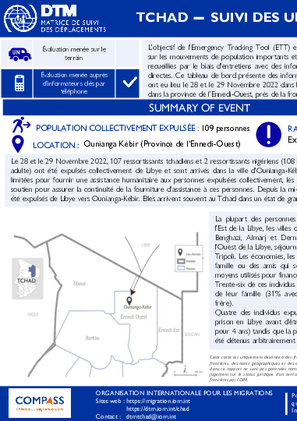
Contact
DTM Chad, dtmtchad@iom.int
Language
French
Location
Chad
Period Covered
Nov 28 2022
Nov 29 2022
Activity
- Mobility Tracking
- Event Tracking
Le 28 et le 29 Novembre 2022, 107 ressortissants tchadiens et 2 ressortissants nigériens (108 hommes adultes et une femme adulte) ont été expulsés collectivement de Libye et sont arrivés dans la ville d'Ounianga-Kébir. Etant donné les ressources limitées pour fournir une assistance humanitaire aux personnes expulsées collectivement, les autorités locales ont besoin de soutien pour assurer la continuité de la fourniture d'assistance à ces personnes. Depuis la mi-avril 2020, 1 776 individus ont été expulsés de Libye vers Ounianga-Kébir. Elles arrivent souvent au Tchad dans un état de grande vulnérabilité.

Contact
DTM Chad, dtmtchad@iom.int
Language
English
Location
Chad
Period Covered
Nov 28 2022
Nov 29 2022
Activity
- Mobility Tracking
- Event Tracking
On the 28 and 29 of November 2022, 107 Chadian nationals and 2 nigerien nationals (108 adults males and one adult female) were collectively expelled from Libya and arrived in the town of Ounianga-Kébir. Given the limited resources to provide humanitarian assistance to collectively expelled persons, local authorities need support to ensure the continued provision of assistance to these persons. Since mid-April 2020, 1,776 individuals have been expelled from Libya to Ounianga-Kébir. They often arrive in Chad in a highly vulnerable state.
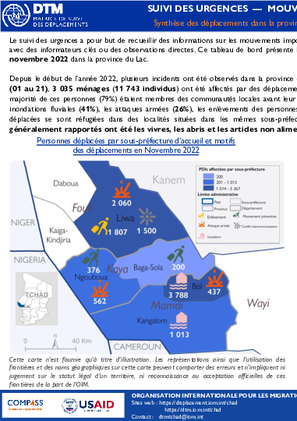
Contact
DTM Chad, dtmtchad@iom.int
Language
French
Location
Chad
Period Covered
Nov 01 2022
Nov 30 2022
Activity
- Mobility Tracking
- Event Tracking
Le suivi des urgences a pour but de recueillir des informations sur les mouvements importants et soudains de populations. Les informations sont collectées à travers des entretiens avec des informateurs clés ou des observations directes. Ce tableau de bord présente les informations sur les mouvements des personnes survenus dans la période du 01 au 21 novembre 2022 dans la province du Lac.
Depuis le début de l’année 2022, plusieurs incidents ont été observés dans la province du Lac entraînant un grand nombre de déplacements. Durant le mois de novembre 2022 (01 au 21), 3 035 ménages (11 743 individus) ont été affectés par des déplacements, soit 65 pour cent de moins comparé à la période du 07 au 31 octobre 2022. Ainsi, la majorité de ces personnes (79%) étaient membres des communautés locales avant leur déplacement. Il est à souligner que ces déplacements ont été principalement causés par les inondations fluviales (41%), les attaques armées (26%), les enlèvements des personnes (15%) et les conflits intercommunautaires (13%). En effet, 67 pour cent des personnes déplacées se sont réfugiées dans des localités situées dans les mêmes sous-préfectures que leurs lieux des provenances (voir le tableau 1). Les besoins immédiats généralement rapportés ont été les vivres, les abris et les articles non alimentaires.

Contact
DTM Chad, dtmtchad@iom.int
Language
English
Location
Chad
Period Covered
Nov 01 2022
Nov 30 2022
Activity
- Mobility Tracking
- Event Tracking
The purpose of the Emergency Tracking Tool (ETT) is to collect information on large and sudden population movements as well as on security and climate emergencies. This dashboard provides information on movements which occurred during the period from 01 to 21 November 2022, in Lac Province.
Since the beginning of 2022, several incidents have been observed in the Lake Province resulting in many displacements. During November 2022, 3,035 households (11,743 individuals) were affected by displacement, which is 65 percent less than the period from 7 to 31 October 2022. The majority of these persons (79%) were local communities before these new displacements. It should be noted that most displacements were mainly caused by river flooding (41%), armed attacks (26%), kidnapping (15%) and intercommunal conflicts (13%). Indeed, 67 percent of displaced individuals took refuge in localities situated in the same sous-préfectures as their locations of provenance (see Table 1). The most reported urgent needs were food, shelter and non-food items.

Contact
DTM Chad, dtmtchad@iom.int
Language
English
Location
Chad
Period Covered
Dec 14 2022
Dec 14 2022
Activity
- Mobility Tracking
- Event Tracking
The objective of the Emergency Tracking Tool (ETT) is to collect information on large and sudden population movements as well as security and climactic emergencies. Information is collected through phone interviews with key informants and direct observation.
Following the increasing water level of Lake Chad, a total of 1,322 households (6,141 individuals) were affected by the floods, among these people, 884 households (3,600 individuals) were displaced on foot and by canoe to the host locations. In addition to displacement, these flooding caused considerable damage to houses, millet, rice, sorghum and okra fields, also resulting in the loss of non-food items and livestock.
Pagination
- Previous page
- Page 7
- Next page
